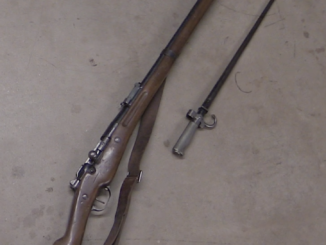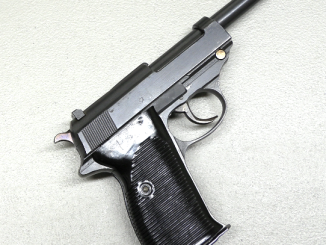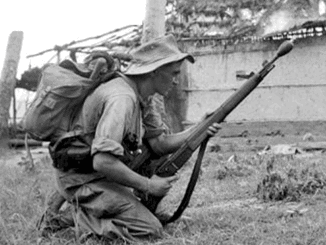The Serbian Army was essentially destroyed in 1915, and lost a massive amount of equipment. It was rebuilt with French assistance and reequipped with French arms in 1917, including about 5,000 Ruby pistols. These were standard French handguns at the time, and those that survived the rest of the war would remain in Yugoslav armories (as the Kingdom of Yugoslavia incorporated the former Serbian nation) well into the 1930s.
What we have today, courtesy of Mike Carrick from Arms Heritage magazine, is one of those Franco-Serbian Rubies, refurbished and remarked by Yugoslavia in 1933.




Well, they were durable for a while. If you have trouble getting the slide off a Ruby for maintenance, either the 7.65 or the little brother 6.35, it’s because the sear has bent and the internal hammer cannot be cocked fully. Ruby owners complain about this on-line without knowing the cause. Frequently the guns still shoot, but be aware that you’re shooting from about three-quarter cock. If you must get the slide off, then you have to pull the hammer spring from the bottom of the grip, which means driving out the pin for the magazine catch and hammer strut, and good luck getting them all back in in less than a day. When the Germans took over the Unique factory in France in WWII, they redesigned Unique’s Ruby with an external hammer, and postwar the French kept manufacturing the external-hammer gun under the name RR51.
If Chauchats went to Serbia, I suppose so should Rubys. They did get around. I have heard of proper factory-made Chinese Rubys, and even a Japanese Ruby, captured by a GI in the Philippines, though whether this last was manufactured in Japan or in Manchuria under Japanese management, I do not know. Thanks again to Mr. M. for expanding our knowledge.
“(…)even a Japanese Ruby, captured by a GI in the Philippines(…)”
Might this be what is known as Sugiura pistol https://guns.fandom.com/wiki/Sugiura_pistol
?
Dear Daewoo: I don’t know. If the Sugiura is an “exact copy” of the Browning 1903, than no, because the 1903 used leaf springs for the magazine catch and sear, and the Ruby uses a coil spring rather like the Big Brother Colt 1911 or Browning GP35. The Japanese Ruby I read about was specifically designated a “Ruby,” and seems to have a shorter barrel than the Colt or Browning 1903s. I just recovered this link: https://www.gunboards.com/threads/japanese-ruby-pistol-opinions-please.387216/
Thanks LDC…
Any idea what causes the sear bending… Soft material… Thin support… Slide impact behind hammer during battery on travel…
Dear Strongarm: Seems to be soft material, per the one article I read. Don’t remember where I read it.
“(…)Yugoslavia in 1933”
Now I confused, then why title screen sports flag with star? To my understanding this was used from 1945 onward. That being said I never felt myself to be expert at successor states of SHS Kingdom, so hopefully someone better versed with that part of history will explain that.
This is a gross error, putting communist yugoslavian post ’45 flag in Kingdom of Yugoslavia timeframe.
I was under the impression that not all Rubys in French service received the stars at the mag well. I have an IS code Ruby with a matching serial number slide and frame. The slide has the holster safety stud added by the French after WWI, so it was definitely in French service, but it does not have the acceptance stars on the mag. well. I have long been attempting to find all of the codes, but so far have only managed 11. Would love to find one of these Yugos, great info and video!!
Hi Andrew
I have been able so far to identify 39 codes associated to Ruby makers, plus 10 more companies having provided partial or complete pistols, but without having been given any letter code. Probably subcontractors. Can send these infos if you are interested.
According to books here in France, 49 manufacturers have been identified.
By the way, it’s a kind of tradition today, especially among the US collectors, to emphasize the flaws of the Rubys.
The truth might be different. Bearing in mind it was a wartime emergency production made in huge numbers, this pistol did the job it was intended for. During 40 years, I read as much eyewitness accounts as possible about WW1; I have never heard of a veteran complaining about the Ruby.
For sure, given the pitched battles of the time, they had lots of opportunities to use it for real.
Less sexy than a P08, yes it is; but the Ruby deserves to be considered as a true little war machine.
Probably right about never seeing French service. Mine (with the two stars) also had a rivit through the frame just in front of the safety. That was done so the edge of a holster would ride over the safety lever and not disengage it. Webley/Enfield revolvers had that little wedge doohicky in front of the cylinders to ease holstering also.
I acquired a Ruby while stationed in Italy in the mid 1960’s. I was working with the Carbinieri up on on the Yugoslav near Udine and we captured a Yugoslav border crosser, possibly a smuggler,who was carry a Ruby pistol and about 50 rounds of WWII ammo (German, Austrian,and Italian headstamps). The Yugoslav decided to resist arrest and suddenly had not further use for the pistol. The Carbinieri gave me the pistol and ammunition as a souvenir. It also has no acceptance marks on the pistol grip nor the stud by the safety but does show much evidence of holster wear. So somebody carried it for a good while.
It is in very good condition, the serial number all match and shoots remarkably well. Maker is AL. I think that if the Ruby was decently manufactured it should be given more respect. Thank you very much for the information you provided in the video.